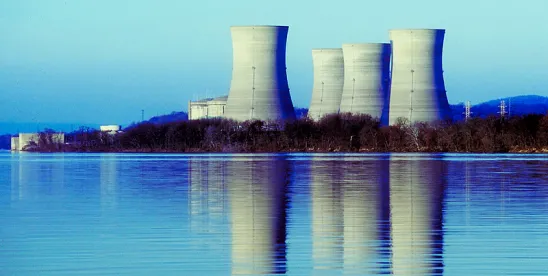The four (4) nuclear energy Executive Orders issued on Friday, May 23, 2025 (Nuclear EOs), set out a 25-year whole-of-government plan for further development and successful deployment of US nuclear technology—both domestically and internationally, and addressing the full scope of the nuclear industry (licensing, fuel life cycle, reactor technology, supply chain, workforce, spent fuel and waste disposal, financing and international agreements)—ultimately culminating in 400 GW of US nuclear energy capacity by 2050.
The volume of required actions illustrates the Trump Administration’s drive to launch a US nuclear renaissance. Within the first 90 days, the Nuclear EOs address establishing domestic fuel supply, regulatory overhauls, fast-tracking reactor deployments utilizing Department of Defense (DOD) and Department of Energy (DOE) jurisdiction, authorizing financial support via US Export-Import Bank (US Ex-Im), agency finance institutions and multilateral banks, and employing diplomatic tools to promote the US nuclear industry. This article highlights key required activities on a year-by-year basis, along with supporting activities to be undertaken in parallel, followed by a comprehensive timeline of all activities and achievements required by the Nuclear EOs.
Required Activities for 2025
The Nuclear EOs mandate the following key activities and achievements for the remainder of 2025:
- designating one or more sites owned or controlled by DOE in the United States for deployment of advanced nuclear reactor technology;
- utilizing the Defense Production Act and developing a plan to accelerate the development of low enriched uranium (LEU) and high assay low enriched uranium (HALEU) capabilities and to address management of spent fuel;
- reforming DOE’s National Environmental Policy Act (NEPA) compliance regime, including determining DOE functions that should not be subject to NEPA;
- expediting intergovernmental agreements on nuclear energy and the fuel supply chain with potential export countries;
- promoting adherence to the Convention on Supplemental Compensation for Nuclear Damage (CSC);
- directing all executive departments and agencies that provide educational grants to prioritize investment in nuclear engineering and other nuclear energy-related careers; and
- leveraging agency finance capabilities toward providing financing for deployment of American nuclear technology.
Required Activities for 2026
The Nuclear EOs mandate the following key activities and achievements for calendar year 2026:
- creating a comprehensive report relating to safe management of spent fuel, including storage, transport, recycling and reprocessing capabilities, and permanent storage;
- wholesale review and revision by the Nuclear Regulatory Commission (NRC) of its regulations and guidance, and issuance of final rules in respect of the same, including a maximum 18-month final decision deadline for applications to construct and operate new reactors and a maximum 12-month final decision deadline for applications to extend operating licenses for existing reactors; and
- submitting recommendations for legislative proposals and regulatory actions regarding placement of advanced nuclear reactors on military installations.
Required Activities from 2027 through 2050
The Nuclear EOs mandate the following key activities and achievements within the years 2027 through 2050:
- November 2027: Beginning operation of an advanced nuclear reactor at a DOE-owned or controlled site for the purpose of powering AI infrastructure, other critical or national security needs or on-site infrastructure;
- September 2028: Beginning operation of a nuclear reactor at a domestic military base or installation;
- January 2029: Completing negotiations of at least 20 new 123 Agreements;
- within calendar year 2030: Facilitating 5 GW of uprates to existing reactors and commencement of construction of at least 10 new, large reactors with complete designs;
- May 2035: Completing re-negotiation of all 123 Agreements originally set to expire by May 2035; and
- within calendar year 2050: Achieving 400 GW of US nuclear energy capacity in operation.
Additional Parallel Activities
In addition to the activities noted above, the Nuclear EOs also require other substantive activities to be undertaken by the NRC, DOE, DOD and Department of State (DOS) on an ongoing basis. We have included another chart below, following the detailed, comprehensive timeline, that lists these parallel activities. These activities range from right-sizing headcounts to continuing regulatory overhauls (particularly within the NRC, as well as environmental regulatory regimes), developing a HALEU fuel bank, expediting decisions on technology transfer export authorization requests, prioritizing issuance of security clearances and supporting diplomatic efforts via 123 Agreements.
Conclusion
The scope and volume of required activities and multi-agency effort under these Nuclear EOs underscore the priority the administration is placing on the accelerated development and deployment of US nuclear technology. As mentioned, we have set out below a comprehensive timeline and list of all activities required by the Nuclear EOs, on a year-by-year and agency-by-agency basis. Hunton plans to issue a series of articles providing more in-depth review and discussion of impacts to the US nuclear industry. We will also continue to monitor any further nuclear energy-related Executive Orders and impacts from pending and newly passed legislation, including impacts to currently available tax credits for the nuclear industry under proposed amendments to the Inflation Reduction Act.
| Timeline of Required Activities and Achievements for Calendar Year 2025 | |
| By June 2025
|
DOE to utilize authority delegated by President under the Defense Production Act to seek voluntary agreements with domestic nuclear energy companies for cooperative procurement of low-enriched uranium (LEU) and high assay, low-enriched uranium (HALEU), prioritizing agreements with companies that have achieved objective milestones (e.g., DOE-approved conceptual safety design reports, ability to privately finance their fuel, demonstrated technology capability), including:
DOE to reform its rules governing compliance with National Environmental Policy Act (NEPA), including determining which DOE functions are not subject to NEPA |
| By July 2025 | DOE to issue guidance on what counts as a ‘qualified test reactor’ |
| By August 2025
|
DOE to:
Director of Office of Science and Technology Policy and Assistant to President for Economic Policy to determine a strategy to address:
Treasury to determine a strategy that:
Department of State (DOS) to implement program to enhance global competitiveness of American nuclear suppliers, investors and lenders to compete for nuclear projects around the globe, including:
|
| By September 2025
|
DOE to develop a plan to expand domestic uranium conversion capacity and enrichment capabilities to meet projected needs for LEU, highly enriched uranium (HEU) and HALEU Department of Labor and Department of Education to increase participation in nuclear energy-related Registered Apprenticeships and Career and Technical Education programs All executive departments and agencies that provide educational grants to consider nuclear engineering and other nuclear energy-related careers as priority area for investment DOE to take steps to increase access to R&D infrastructure, workforce and expertise at DOE National Labs for (i) college and university students studying nuclear engineering and other nuclear energy-related fields and (ii) DOD personnel affiliated with nuclear energy programs |
| By November 2025
|
DOE to coordinate with Small Business Administration (SBA) to prioritize funding for qualified advanced nuclear technologies through grants, loans, investment capital, funding opportunities, etc., with priority to companies demonstrating largest degrees of design and technological maturity, financial backing and potential for near-term deployment |
| Timeline of Required Activities and Achievements for Calendar Year 2026 | |
| By January 2026
|
DOE to prepare a comprehensive report, providing (among other aspects):
DOD, in coordination with DOE, to prepare and submit to Assistant to the President for National Security Affairs, recommendations for legislative proposals and regulatory actions regarding the distribution, operation, replacement and removal of advanced nuclear reactors and spent nuclear fuel on military installations |
| By February 2026
|
Nuclear Regulatory Commission (NRC) to complete wholesale review and revision of regulations and guidance, and issue a notice of proposed rulemaking, including:
|
| By July 2026
|
DOE to create a pilot program for reactor construction and operation outside the National Labs, and approve at least three reactors with the goal of achieving criticality for each by July 4, 2026 |
| By November 2026 | NRC to issue final rules and guidance to conclude its regulatory revision process |
| Timeline of Required Activities and Achievements for Calendar Years 2027 through 2050 | |
| By November 2027
|
DOE to begin operating an advanced nuclear reactor, following siting, approval and authorization of the design, construction and operation of privately funded advanced nuclear reactor technologies at DOE-owned or controlled sites for purpose of powering AI infrastructure, other critical or national security needs, supply chain items or on-site infrastructure |
| By September 2028
|
DOD to begin operating a nuclear reactor at a domestic military base or installation by September 30, 2028
DOD to prepare and submit recommendations for legislative and regulatory actions regarding distribution, operation, replacement and removal of advanced nuclear reactors and spent nuclear fuel on military installations |
| By January 2029 | At least 20 new 123 Agreements negotiated |
| Within Year 2030 | Facilitate 5 GW uprates to existing reactors and have ten new, large reactors with complete designs under construction |
| By May 2035 | Completed re-negotiation of all 123 Agreements originally set to expire by May 2035 |
| Within Year 2050 | 400 GW of US nuclear energy capacity in operation |
| Additional Required Parallel Activities |
| NRC |
|
| DOE |
|
| DOD |
|
| DOE and DOD, together |
|
| Department of State |
|







 />i
/>i
